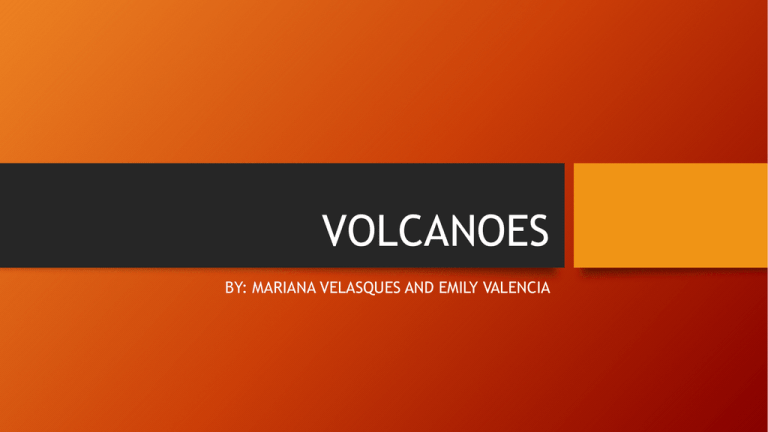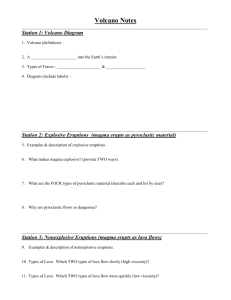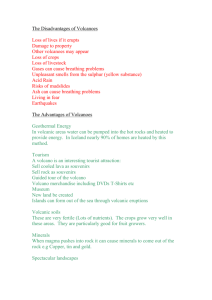VOLCANOES
advertisement

VOLCANOES BY: MARIANA VELASQUES AND EMILY VALENCIA DEFINITION • Is a rupture in the Earth's crust where molten lava, hot ash, and gases from below the Earth’s crust escape into the air. PARTS OF A VOLCANO • Magma - Molten rock beneath Earth's surface. • Parasitic Cone - A small cone-shaped volcano formed by an accumulation of volcanic debris. • Sill - A flat piece of rock formed when magma hardens in a crack in a volcano. • Vent - An opening in Earth's surface through which volcanic materials escape. • Flank - The side of a volcano. • Lava - Molten rock that erupts from a volcano that solidifies as it cools. PARTS OF A VOLCANOE • Crater - Mouth of a volcano - surrounds a volcanic vent. • Conduit - An underground passage magma travels through. • Summit - Highest point; apex • Throat - Entrance of a volcano. The part of the conduit that ejects lava and volcanic ash. • Ash Cloud - A cloud of ash formed by volcanic explosions. • Ash - Fragments of lava or rock smaller than 2 mm in size that are blasted into the air by volcanic explosions. HOW DO VOLCANOES FORM ? • Deep inside Earth, between the molten iron core and the thin crust at the surface, there is a solid body of rock called the mantle. • When rock from the mantle melts, moves to the surface through the crust, and releases pent-up gases, volcanoes erupt. • Extremely high temperature and pressure cause the rock to melt and become liquid rock or magma. When a large body of magma has formed, it rises through the denser rock layers toward Earth's surface. Magma that has reached the surface is called lava. CHARACTERISTICS • As discussed above, there are particular physicochemical characteristics associated with explosive and peaceful volcanic eruptions. It is useful to now summarize the characteristics of mafic and felsic eruptions, as well as describe the physical properties of the rocks formed by such eruptions. • Basaltic composition lavas erupt at temperatures between 1000 and 1200 °C and are characterized by extremely low viscosity. As such, basaltic lavas tend to flow freely for great distances over the Earth’s surface. TYPES Volcanoes can be described in terms of activity and can be: • still active and erupt frequently • dormant (temporarily inactive but not fully extinct) • extinct (never likely to erupt again) FACTS • Most eruptions occur when gas expands inside the Earth, reducing pressure and causing aggressive volcanic behavior. • Expelled magma on the surface of the Earth can take up to several hundred years to cool depending on its composition and location. • A volcano is formed by eruptions of lava and ash. • Volcanoes are usually cone shaped mountains or hills. • When magma reaches the Earth's surface it is called lava. When the lava cools, it forms rock. • Volcanic eruptions can happen at destructive and constructive boundaries, but not at conservative boundaries. • Some volcanoes happen underwater, along the seabed or ocean floor. REFERENCES • http://www.yourdictionary.com/volcano • http://resources.woodlandsjunior.kent.sch.uk/homework/mountains/volcanoparts.html







